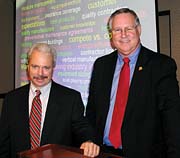
According to Don Fremberg, chairman of HARDI, attendance was "up well over 100, and we expect to break records in Chicago next year." This year's convention marks the first official event since the merger of Northamerican Heating, Refrigeration & Airconditioning Wholesalers (NHRAW) and the Air-conditioning and Refrigeration Wholesalers International (ARWI).
Outgoing president Doug Young, of The Behler-Young Company, Grand Rapids, Mich., warned his fellow distributors that "traditional margin structures will continue to erode." He then challenged the group to provide value in the market and to "pull the industry up by its bootstraps by promoting comfort in the home through builders and contractors."
The HVAC Systems and Equipment Council featured a look into the future from the perspective of the manufacturer and dealer. Richard Specht of American Standard predicted major shifts towards 12-SEER equipment in advance of the DOE Standard in 2006 and that sales of R-410A products will grow at 10 percent per year. Technology changes will include 20-SEER equipment, interactive controls for ease of servicing, and more consumer options on HVAC equipment, said Specht. His company also foresees continued industry growth of 1.5 to 5 percent for the next five years.
Larry Taylor, president of Air Rite Air Conditioning, Fort Worth, Texas, outlined several trends to watch over the next five years, including transforming markets that are impacted by a more discriminating customer. He also predicted indoor environmental quality would become a major influence, and it would include comfort issues such as noise, vibration, and lighting.
"This means HVAC contractors will have to partner with other trades," said Taylor, who is past president of Air Conditioning Contractors of America (ACCA) and a member of a futures committee involving ACCA and the Air-Conditioning and Refrigeration Institute (ARI).
Taylor went on to predict utility deregulation would mean that utilities would become "a customer, a competitor, and a player in the market." He added that the technician shortage will continue, and the trend would spur manufacturers to develop more intelligent products that are easier to service.
Publication date: 12/29/2003
